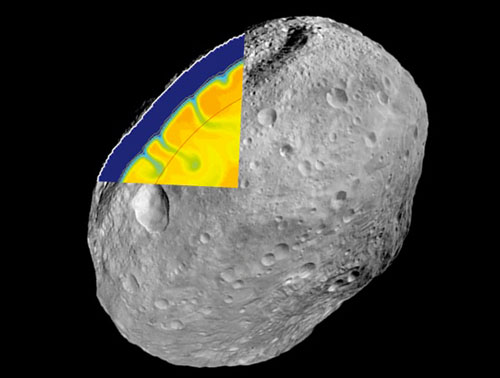| Jan 24, 2013 |
Asteroid with active past
|
|
(Nanowerk News) Based on images taken by the NASA mission “Dawn”, the beholder cannot help but dismiss the asteroid Vesta as “dead” rock. However, the latest findings reveal that the asteroid with a mean diameter of about 516 kilometres has had an active past. Using mineralogical and crystallographic analyses of the meteorite Northwest Africa 5480, a so-called diogenite which came from Vesta, researchers from the Goethe University Frankfurt found evidence that similar dynamic processes to those that occur in planets initially took place inside Vesta. Numerical simulations by geophysicist Gregor Golabek using ETH Zurich’s Brutus Cluster reinforce this hypothesis.
|
 |
| A black-and-white mosaic image of Vesta taken from NASA’s Dawn spacecraft, superimposed with an image from a numerical simulation of Vesta’s thermal evolution within its first 50 million years. It shows a dynamic interior with solidified material sinking into an underlying partially molten mantle. (Credit: F.E. Brenker, NASA DAWN and G.J. Golabek)
|
|
Rock movements in the young asteroid
|
|
Vesta is known to be the only intact asteroid in the Main Asteroid Belt that is similar in structure to the inner planets of our solar system. Based on what we know today, Vesta consists of an iron core, a silicate mantle and an outer crust made of basalt. Evidence of its internal structure was provided by the Hubble Space Telescope.
|
|
While studying Northwest Africa 5480’s minerals, Beverley Tkalcec and Frank Brenker from the Goethe University Frankfurt have now discovered that Vesta was not only differentiated in terms of the crust-mantle-core like planets, but also that there must have been movements and material transport in Vesta’s mantle once upon a time, as evidenced by the alignment of the crystal axis of the rock’s minerals and arrangement of their crystal lattices.
|
|
Based on a special microstructural analysis, the scientists found similar displacements in the minerals of the diogenite meteorite to those that occur in mantle rock on Earth. According to the researchers, this was the first instance the research method had been used on a meteorite. It enabled them to show that the diogenite meteorite was not formed as a cumulate in a magma chamber in Vesta’s lower crust or the upper mantle as presumed. They were also able to rule out that the typical crystal pattern of the olivine and orthopyroxene crystals was formed through a collision with another celestial body. Instead, as the researchers write in their paper just published in Nature Geoscience ("Solid-state plastic deformation in the dynamic interior of a differentiated asteroid"), the microstructural analysis suggests that the minerals sank into the partially molten mantle after crystallisation, where they were deformed at least twice at temperatures of between 1,000 and 1,250 degrees Celsius.
|
|
Simulations confirm crystallographic findings
|
|
In order to verify the unexpected results, the scientists from Frankfurt turned to Gregor Golabek, a senior researcher at ETH Zurich’s Institute of Geophysics who specialises in simulating processes inside planets. Golabek fed the data available, such as the size of the asteroid and its presumed period of origin, into his numerical simulations. Based on the models, he was able to ascertain whether deformations were possible in the expected temperature and depth range.
|
|
Golabek’s simulations reveal that in the first fifty million years after its formation, crystallised-out areas formed in the upper mantle on the asteroid Vesta and sank into the mantle on a large scale. Based on this and the deformations of the crystals observed, the researchers are convinced that movements must have occurred in Vesta’s partially molten mantle, much like the convection currents found in the Earth’s mantle today.
|
|
“The study shows that the existing models on the formation of rocks in the Vesta meteorites need to be reconsidered and that large asteroids were geologically active in their early phase and exhibited planet-like processes,” stresses Golabek. For the researchers, the short-lived radioactive isotope Aluminium-26 is the primary candidate as an energy source for the process, which only existed in the early solar system with a half-life of less than a million years.
|
|
Meteorite comes from Vesta’s crater
|
|
The scientists assume that the meteorite they have been studying comes from the so-called Rheasilvia Crater at Vesta’s south pole. Vesta’s largest crater resulted from a collision with a celestial body that was approximately fifty kilometres in size. The impact must have been so great that material, which must also have included that from the upper mantle, was knocked out of the asteroid. Sometimes, the debris from the collision is found on Earth in the form of meteorites – one of which is Northwest Africa 5480.
|
|
As the results of the study suggest that Northwest Africa 5480 comes from Vesta’s upper mantle, the scientists were also able to demonstrate that part of the deformed crystals was “fossilised” in the upper mantle when Vesta cooled down before they were able to sink to greater depths. According to the researchers, the kind of deformation of the crystals and lack of melt in the rock led them to conclude that their deformation did not take place in the molten areas of the mantle. In order to keep the movement processes going, however, Vesta’s mantle must have been partially molten during the first 100 million years. When Vesta solidified once and for all is currently the subject of great debate among experts.
|

